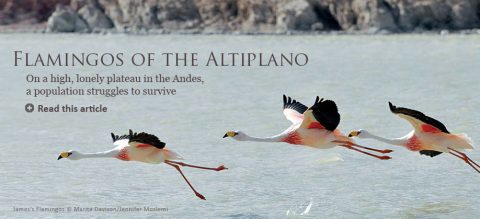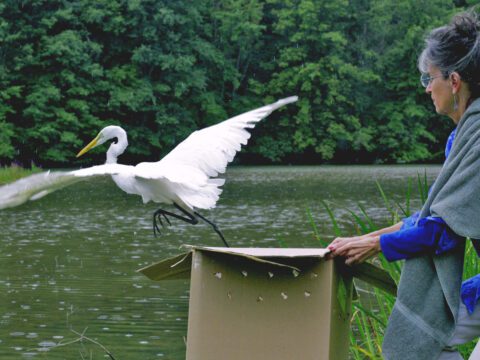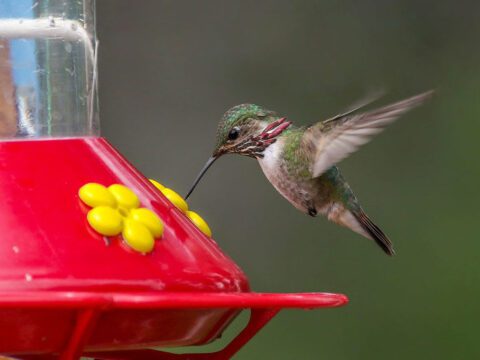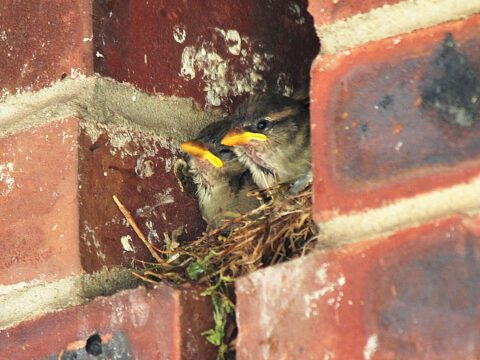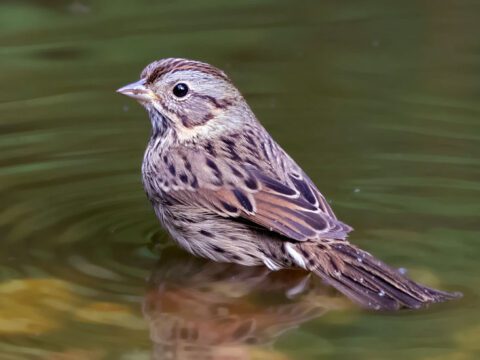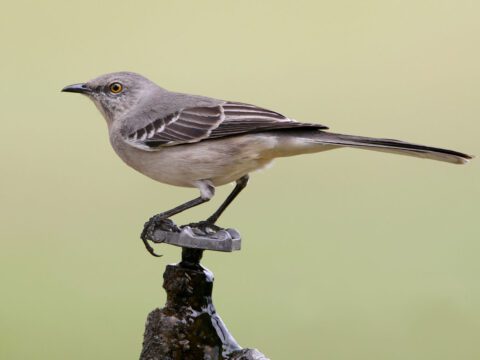Flamingos of the Altiplano, High in the Bolivian Andes
text and photographs by Marita Davison and Jennifer Moslemi
July 15, 2010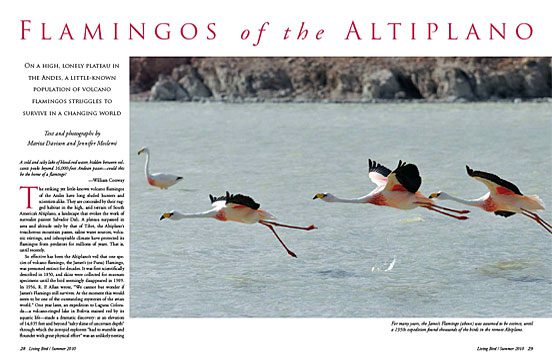
A cold and salty lake of blood-red water, hidden between volcanic peaks beyond 16,000-foot Andean passes—could this be the home of a flamingo?
—William Conway
The striking yet little-known volcano flamingos of the Andes have long eluded hunters and scientists alike. They are concealed by their rugged habitat in the high, arid terrain of South America’s Altiplano, a landscape that evokes the work of surrealist painter Salvador Dali. A plateau surpassed in area and altitude only by that of Tibet, the Altiplano’s treacherous mountain passes, saline water sources, volcanic stirrings, and inhospitable climate have protected its flamingos from predators for millions of years. That is, until recently.
So effective has been the Altiplano’s veil that one species of volcano flamingo, the James’s (or Puna) Flamingo, was presumed extinct for decades. It was first scientifically described in 1850, and skins were collected for museum specimens until the bird seemingly disappeared in 1909. In 1956, R. P. Allan wrote, “We cannot but wonder if James’s Flamingo still survives. At the moment this would seem to be one of the outstanding mysteries of the avian world.” One year later, an expedition to Laguna Colorada—a volcano-ringed lake in Bolivia stained red by its aquatic life—made a dramatic discovery: at an elevation of 14,035 feet and beyond “salty slime of uncertain depth” through which the intrepid explorers “had to stumble and flounder with great physical effort” was an unlikely nesting colony of thousands of flamingos. Within this colony they found all three species of volcano flamingo—the Chilean, Andean, and, what they had hoped still existed, the elusive James’s. These first explorers would be followed by an expedition led by William Conway in 1960. Conway described the terrain surrounding the flamingo colony: “The bottom was riddled with apparently bottomless holes where subterranean geysers pour into the lake. We found it important to stay close so we might drag each other out of these holes. Progress became a series of short struggles punctuated with rest periods while we stood covered from head to foot with mud and gasped at each other.”
It became clear: these flamingos know how to elude predators. Any nonflying predator would not only need to withstand the harsh conditions of the Altiplano, but also defy seemingly bottomless saline mud to get to an egg or a tasty chick. A flying predator would face thin air and intense, relentless wind. No easy task.
The advent of human technology, however, has lifted the heavy veil of the Andes, and the volcano flamingos are no longer protected from potential threats. What was once a forgotten landscape is now a destination for mining companies, developers, and tourists, bringing unknown consequences for these once-isolated birds. A closer look at the three species of volcano flamingos, the new threats they face today, and recent scientific research sheds light on these hardy yet vulnerable creatures that call the unforgiving Altiplano their home.
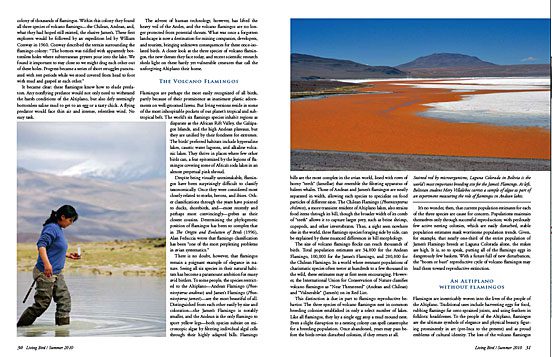
The Volcano Flamingos
Flamingos are perhaps the most easily recognized of all birds, partly because of their prominence as inanimate plastic adornments on well-groomed lawns. But living versions reside in some of the most inhospitable pockets of our planet’s tropical and subtropical belt. The world’s six flamingo species inhabit regions as disparate as the African Rift Valley, the Galápagos Islands, and the high Andean plateaus, but they are unified by their fondness for extremes. The birds’ preferred habitats include hypersaline lakes, caustic water lagoons, and alkaline volcanic lakes. They thrive in places where few other birds can, a feat epitomized by the legions of flamingos covering some of Africa’s soda lakes in an almost perpetual pink shroud.
Despite being visually unmistakable, flamingos have been surprisingly difficult to classify taxonomically. Once they were considered most closely related to storks, herons, and ibises. Other classifications through the years have pointed to ducks, shorebirds, and—most recently and perhaps most convincingly—grebes as their closest cousins. Determining the phylogenetic position of flamingos has been so complex that in The Origin and Evolution of Birds (1996), Alan Feduccia wrote that flamingo classification has been “one of the most perplexing problems in avian systematics.”
There is no doubt, however, that flamingos remain a poignant example of elegance in nature. Seeing all six species in their natural habitats has become a paramount ambition for many avid birders. To some people, the species restricted to the Altiplano—Andean Flamingo (Phoenicopterus andinus) and James’s Flamingo (Phoenicopterus jamesi)—are the most beautiful of all. Distinguished from each other easily by size and coloration—the James’s Flamingo is notably smaller, and the Andean is the only flamingo to sport yellow legs—both species subsist on microscopic algae by filtering individual algal cells through their highly adapted bills. Flamingo bills are the most complex in the avian world, lined with rows of horny “teeth” (lamellae) that resemble the filtering apparatus of baleen whales. Those of Andean and James’s flamingos are neatly separated in width, allowing each species to specialize on food particles of different sizes. The Chilean Flamingo (Phoenicopterus chilensis), a more transient resident of Altiplano lakes, also strains food items through its bill, though the broader width of its comb of “teeth” allows it to capture larger prey, such as brine shrimp, copepods, and other invertebrates. Thus, a sight seen nowhere else in the world, three flamingo species foraging side by side, can be explained by these nuanced differences in bill morphology.
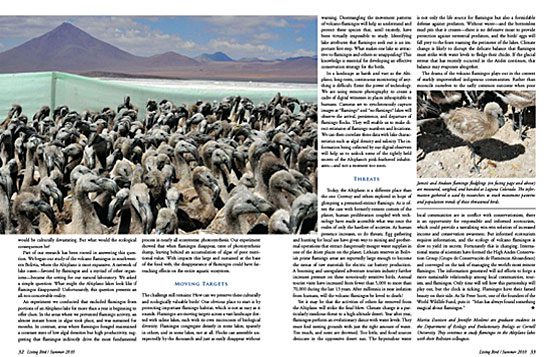
The size of volcano flamingo flocks can reach thousands of birds. Total population estimates are 34,000 for the Andean Flamingo, 100,000 for the James’s Flamingo, and 200,000 for the Chilean Flamingo. In a world where remnant populations of charismatic species often teeter at hundreds to a few thousand in the wild, these estimates may at first seem encouraging. However, the International Union for Conservation of Nature classifies volcano flamingos as “Near Threatened” (Andean and Chilean) and “Vulnerable” (James’s) on its Red List.
This distinction is due in part to flamingo reproductive behavior. The three species of volcano flamingos nest in common breeding colonies established in only a select number of lakes. Like all flamingos, they lay a single egg atop a mud mound nest. Even a slight disruption to a nesting colony can spell catastrophe for a breeding population. Once abandoned, years may pass before the birds revisit disturbed colonies, if they return at all.
It’s no wonder, then, that current population estimates for each of the three species are cause for concern. Populations maintain themselves only through successful reproduction; with perilously few active nesting colonies, which are easily disturbed, stable population estimates mask worrisome population trends. Given, for example, that nearly one-third of the entire population of James’s Flamingo breeds at Laguna Colorada alone, the stakes are high. It is, so to speak, putting all of the flamingo eggs in dangerously few baskets. With a future full of new disturbances, the “boom or bust” reproductive cycle of volcano flamingos may lead them toward reproductive extinction.
An Altiplano without flamingos
Flamingos are inextricably woven into the lives of the people of the Altiplano. Traditional uses include harvesting eggs for food, rubbing flamingo fat onto sprained joints, and using feathers in folkloric headdresses. To the people of the Altiplano, flamingos are the ultimate symbols of elegance and physical beauty, figuring prominently in art (pre-Inca to the present) and as proud emblems of cultural identity. The loss of the volcano flamingos would be culturally devastating. But what would the ecological consequences be?
Part of our research has been rooted in answering this question. We began our study of the volcano flamingos in southwestern Bolivia, where the Altiplano is most expansive. A network of lake oases—favored by flamingos and a myriad of other organisms— became the setting for our natural laboratory. We asked a simple question: What might the Altiplano lakes look like if flamingos disappeared? Unfortunately, this question presents an all-too-conceivable reality.
An experiment we conducted that excluded flamingos from portions of an Altiplano lake for more than a year is beginning to offer clues. In the areas where we prevented flamingo activity, an almost instant boom in algae took place, and was sustained for months. In contrast, areas where flamingos foraged maintained a constant state of low algal densities but high productivity, suggesting that flamingos indirectly drive the most fundamental process in nearly all ecosystems: photosynthesis. Our experiment showed that when flamingos disappear, rates of photosynthesis slump, leaving behind an accumulation of algae of poor nutritional value. With impacts this large and sustained at the base of the food web, the disappearance of flamingos could have far reaching effects on the entire aquatic ecosystem.
Moving Targets
The challenge still remains: How can we preserve these culturally and ecologically valuable birds? One obvious place to start is by protecting important flamingo habitat, which is not as easy as it sounds. Flamingos are moving targets across a vast landscape dotted with saline lakes, each with its own microcosm of biological diversity. Flamingos congregate densely in some lakes, sparsely in others, and in some lakes, not at all. Flocks can assemble unexpectedly by the thousands and just as easily disappear without warning. Disentangling the movement patterns of volcano flamingos will help us understand and protect these species that, until recently, have been virtually impossible to study. Identifying lake attributes that flamingos seek out is an important first step. What makes one lake so attractive to flamingos and others so unappealing? This knowledge is essential for developing an effective conservation strategy for the birds.
In a landscape as harsh and vast as the Altiplano, long-term, continuous monitoring of anything is difficult. Enter the power of technology. We are using remote photography to create a cadre of digital witnesses in places inhospitable to humans. Cameras set to synchronously capture images at “flamingo” and “no flamingo” lakes will observe the arrival, persistence, and departure of flamingo flocks. They will enable us to make direct estimates of flamingo numbers and locations. We can then correlate these data with lake characteristics such as algal density and salinity. The information being collected by our digital observers will help us to unlock some of the tightly held secrets of the Altiplano’s pink-feathered inhabitants— and not a moment too soon.
Threats
Today, the Altiplano is a different place than the one Conway and others explored in hope of glimpsing a presumed-extinct flamingo. As is often the case with formerly remote corners of the planet, human proliferation coupled with technology have made accessible what was once the realm of only the hardiest of societies. As human presence increases, so do threats. Egg gathering and hunting for local use have given way to mining and geothermal operations that extract dangerously meager water supplies in one of the driest places on the planet. Lithium reserves in Bolivia’s prime flamingo areas are reportedly large enough to become the nexus of raw materials for electric car battery production. A booming and unregulated adventure tourism industry further increases pressure on these notoriously sensitive birds. Annual tourist visits have increased from fewer than 5,000 to more than 70,000 during the last 13 years. After millennia in near isolation from humans, will the volcano flamingos be loved to death?
Yet it may be that the activities of others far removed from the Altiplano will strike the final blow. Climate change is a particularly insidious threat to a high-altitude desert. Year after year, flamingos perform an evolutionary dance with water levels. They must find nesting grounds with just the right amount of water. Too much, and nests are drowned. Too little, and food sources desiccate in the oppressive desert sun. The hypersaline water is not only the life source for flamingos but also a formidable defense against predators. Without water—and the bottomless mud pits that it creates—there is no defensive moat to provide protection against terrestrial predators, and the birds’ eggs will fall prey to the foxes roaming the perimeter of the lakes. Climate change is likely to disrupt the delicate balance that flamingos must strike with water levels to fledge their chicks. If the glacial retreat that has recently occurred in the Andes continues, this balance may evaporate altogether.
The drama of the volcano flamingos plays out in the context of starkly impoverished indigenous communities. Rather than reconcile ourselves to the sadly common outcome when poor local communities are in conflict with conservationists, there is an opportunity for responsible and informed ecotourism, which could provide a tantalizing win-win solution of increased income and conservation awareness. But informed ecotourism requires information, and the ecology of volcano flamingos is slow to yield its secrets. Fortunately this is changing. International teams of scientists have formed the High Andes Conservation Group (Grupo de Conservación de Flamencos Altoandinos) and converged on the task of managing the world’s most remote flamingos. The information generated will aid efforts to forge a more sustainable relationship among local communities, tourists, and flamingos. Only time will tell how this partnership will play out, but the clock is ticking. Flamingos have their famed beauty on their side. As Sir Peter Scott, one of the founders of the World Wildlife Fund, puts it: “Man has always found something magical about flamingos.”
Marita Davison and Jennifer Moslemi are graduate students in the Department of Ecology and Evolutionary Biology at Cornell University. They continue to study flamingos in the Altiplano lakes with their Bolivian colleagues.

All About Birds
is a free resource
Available for everyone,
funded by donors like you
American Kestrel by Blair Dudeck / Macaulay Library
